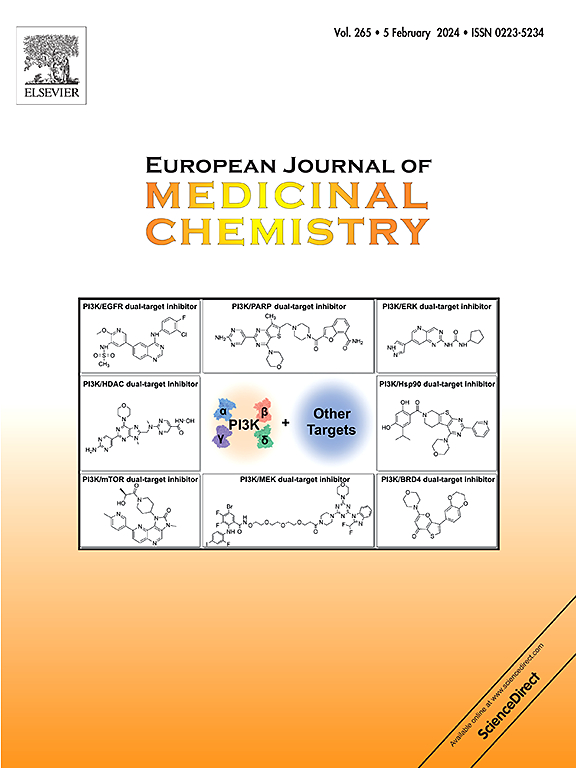针对激素相关癌症的杂环雄烷衍生物:合成、生物活性和对接研究
IF 6
2区 医学
Q1 CHEMISTRY, MEDICINAL
引用次数: 0
摘要
在类固醇核心中插入杂环可以增强生物活性,提高选择性并减少潜在癌症治疗药物的副作用。本文研究了新型噻唑啉、噻二唑啉和噻唑烷酮类甾体化合物与内酯、内酰胺或吡啶结合的合成。这些类固醇杂化分子可能是药物设计的潜在候选者,具有更好的生物活性和生物利用度。采用多相法对起始雄烯二酮或脱氢表雄酮进行修饰,合成硫代氨基脲酮雄烯衍生物,作为合成新的杂环化合物的直接前体。对五种癌细胞系:乳腺腺癌细胞(MCF7)、急性淋巴细胞白血病(CCRF-CEM)、宫颈癌细胞(HeLa)、激素不依赖型(DU 145)和激素敏感型前列腺癌细胞(LNCaP)以及正常皮肤成纤维细胞(BJ)进行了细胞毒性试验。化合物5和16选择性最强,均能诱导HeLa细胞凋亡。在酵母细胞中利用荧光法评价了新化合物与雌激素受体α (ERα)、雌激素受体β (ERβ)、雄激素受体(AR)或糖皮质激素受体(GR)配体结合结构域(lbd)的相对结合亲和力,其中噻唑衍生物13对ERα的结合亲和力最高,而噻唑烷酮7对ERβ的选择性亲和力较强。此外,通过荧光光谱法评估了乙酰氨基噻二唑啉21对人醛酮还原酶1C3和1C4 (AKR1C3和AKR1C4)的抑制潜力,发现乙酰氨基噻二唑啉21对AKR1C3的IC50值略高于对照抑制剂布洛芬。通过分子对接研究,在体外实验的基础上,提出了对特定蛋白亲和力最强的化合物的蛋白质-配体结合模型。总之,我们的研究结果表明,所测试的杂环衍生物对激素依赖性癌细胞有活性,并为开发新的治疗方法提供了有希望的线索。本文章由计算机程序翻译,如有差异,请以英文原文为准。

Heterocyclic androstane derivatives targeting hormone-related cancers: Synthesis, bioactivity and docking studies
Insertion of a heterocyclic ring into the steroid core could enhance bioactivity, improve selectivity and reduce side effects in potential drugs for cancer therapy. The present study describes the synthesis of new thiazoline, thiadiazoline and thiazolidinone steroid compounds combined with lactone, lactam or pyridine moieties. These steroid hybrid molecules may be potential candidates for drug design, with improved biological activity and bioavailability. The starting androstenedione or dehydroepiandrosterone were modified by multiphase synthesis into thiosemicarbazone androstane derivatives, direct precursors for the synthesis of new heterocyclic compounds. Their cytotoxicity was tested against five cancer cell lines: breast adenocarcinoma cells (MCF7), acute lymphoblastic leukemia (CCRF-CEM), cervical carcinoma cells (HeLa), hormone-independent (DU 145) and hormone-sensitive prostate cancer cells (LNCaP), as well as against normal skin fibroblasts (BJ). Compounds 5 and 16 were found to be the most selective, with both inducing apoptosis in HeLa cells. New compounds were also evaluated for their relative binding affinities for the ligand-binding domains (LBDs) of estrogen receptor α (ERα), estrogen receptor β (ERβ), androgen receptor (AR) or glucocorticoid receptor (GR) using a fluorescent assay in yeast cells, where thiazole derivative 13 exhibited the highest binding affinity for ERα, while thiazolidinone 7 showed strong selective affinity for ERβ. Furthermore, inhibition potential against human aldo-keto reductase 1C3 and 1C4 (AKR1C3 and AKR1C4) was evaluated by fluorescence spectroscopy, with acetamido thiadiazoline 21 displaying an IC50 value for AKR1C3 slightly higher than the reference inhibitor ibuprofen. Molecular docking studies were used to propose protein-ligand binding models for compounds showing the strongest affinity toward specific proteins based on in vitro experiments. In summary, our results suggest that the tested heterocyclic derivatives are active against hormone-dependent cancer cells and represent promising leads for the development of novel therapeutics.
求助全文
通过发布文献求助,成功后即可免费获取论文全文。
去求助
来源期刊
CiteScore
11.70
自引率
9.00%
发文量
863
审稿时长
29 days
期刊介绍:
The European Journal of Medicinal Chemistry is a global journal that publishes studies on all aspects of medicinal chemistry. It provides a medium for publication of original papers and also welcomes critical review papers.
A typical paper would report on the organic synthesis, characterization and pharmacological evaluation of compounds. Other topics of interest are drug design, QSAR, molecular modeling, drug-receptor interactions, molecular aspects of drug metabolism, prodrug synthesis and drug targeting. The journal expects manuscripts to present the rational for a study, provide insight into the design of compounds or understanding of mechanism, or clarify the targets.

 求助内容:
求助内容: 应助结果提醒方式:
应助结果提醒方式:


